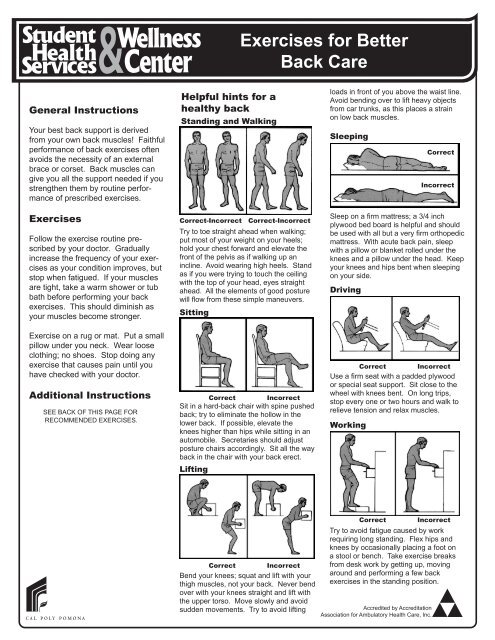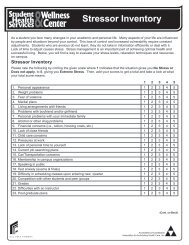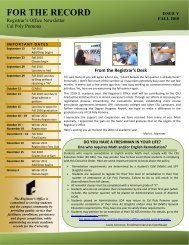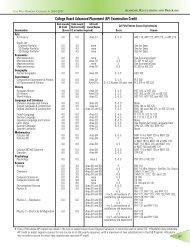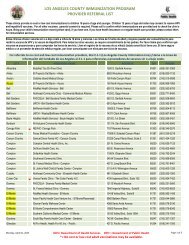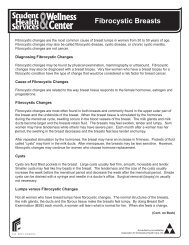Exercises for Better Back Care
Exercises for Better Back Care
Exercises for Better Back Care
You also want an ePaper? Increase the reach of your titles
YUMPU automatically turns print PDFs into web optimized ePapers that Google loves.
<strong>Exercises</strong> <strong>for</strong> <strong>Better</strong><br />
<strong>Back</strong> <strong>Care</strong><br />
General Instructions<br />
Your best back support is derived<br />
from your own back muscles! Faithful<br />
per<strong>for</strong>mance of back exercises often<br />
avoids the necessity of an external<br />
brace or corset. <strong>Back</strong> muscles can<br />
give you all the support needed if you<br />
strengthen them by routine per<strong>for</strong>mance<br />
of prescribed exercises.<br />
<strong>Exercises</strong><br />
Follow the exercise routine prescribed<br />
by your doctor. Gradually<br />
increase the frequency of your exercises<br />
as your condition improves, but<br />
stop when fatigued. If your muscles<br />
are tight, take a warm shower or tub<br />
bath be<strong>for</strong>e per<strong>for</strong>ming your back<br />
exercises. This should diminish as<br />
your muscles become stronger.<br />
Exercise on a rug or mat. Put a small<br />
pillow under you neck. Wear loose<br />
clothing; no shoes. Stop doing any<br />
exercise that causes pain until you<br />
have checked with your doctor.<br />
Additional Instructions<br />
SEE BACK OF THIS PAGE FOR<br />
RECOMMENDED EXERCISES.<br />
Helpful hints <strong>for</strong> a<br />
healthy back<br />
Standing and Walking<br />
Correct-Incorrect Correct-Incorrect<br />
Try to toe straight ahead when walking;<br />
put most of your weight on your heels;<br />
hold your chest <strong>for</strong>ward and elevate the<br />
front of the pelvis as if walking up an<br />
incline. Avoid wearing high heels. Stand<br />
as if you were trying to touch the ceiling<br />
with the top of your head, eyes straight<br />
ahead. All the elements of good posture<br />
will flow from these simple maneuvers.<br />
Sitting<br />
Correct Incorrect<br />
Sit in a hard-back chair with spine pushed<br />
back; try to eliminate the hollow in the<br />
lower back. If possible, elevate the<br />
knees higher than hips while sitting in an<br />
automobile. Secretaries should adjust<br />
posture chairs accordingly. Sit all the way<br />
back in the chair with your back erect.<br />
Lifting<br />
loads in front of you above the waist line.<br />
Avoid bending over to lift heavy objects<br />
from car trunks, as this places a strain<br />
on low back muscles.<br />
Sleeping<br />
Correct<br />
Incorrect<br />
Sleep on a firm mattress; a 3/4 inch<br />
plywood bed board is helpful and should<br />
be used with all but a very firm orthopedic<br />
mattress. With acute back pain, sleep<br />
with a pillow or blanket rolled under the<br />
knees and a pillow under the head. Keep<br />
your knees and hips bent when sleeping<br />
on your side.<br />
Driving<br />
Correct Incorrect<br />
Use a firm seat with a padded plywood<br />
or special seat support. Sit close to the<br />
wheel with knees bent. On long trips,<br />
stop every one or two hours and walk to<br />
relieve tension and relax muscles.<br />
Working<br />
Correct<br />
Incorrect<br />
Bend your knees; squat and lift with your<br />
thigh muscles, not your back. Never bend<br />
over with your knees straight and lift with<br />
the upper torso. Move slowly and avoid<br />
sudden movements. Try to avoid lifting<br />
Correct Incorrect<br />
Try to avoid fatigue caused by work<br />
requiring long standing. Flex hips and<br />
knees by occasionally placing a foot on<br />
a stool or bench. Take exercise breaks<br />
from desk work by getting up, moving<br />
around and per<strong>for</strong>ming a few back<br />
exercises in the standing position.<br />
Accredited by Accreditation<br />
Association <strong>for</strong> Ambulatory Health <strong>Care</strong>, Inc.
1.<br />
Lie on your back with knees bent and hands clasped behind<br />
neck. Feet flat on the floor. Take a deep breath and relax.<br />
Press the small of your back against the floor and lighten<br />
your stomach and buttock muscles. This should cause the<br />
lower end of the pelvis to rotate <strong>for</strong>ward and flatten your back<br />
against the floor. Hold <strong>for</strong> five seconds. Relax.<br />
5.<br />
a. Lie on your stomach with hands clasped behind<br />
back. Pull shoulders back and down by pushing<br />
hands downwards towards feet, pinching shoulder<br />
blades together, and lift head from floor. Take a deep<br />
breath. Hold <strong>for</strong> two seconds. Relax.<br />
b. Stand erect. With one hand grasp the thumb of<br />
other hand behind back, then pull downwards toward<br />
the floor; stand on toes and look at the ceiling while<br />
exerting the downward pull. Hold momentarily, then<br />
relax. Repeat 10 times at intervals of two hours<br />
during the working day. Take an exercicse break<br />
instead of a coffee break!<br />
2.<br />
Lie on your back with knees bent. Feet flat on the floor. Take<br />
a deep breath and relax. Grasp one knee with both hands<br />
and pull as close to your chest as possible. Return to starting<br />
position. Straighten leg. Repeat with alternate leg.<br />
6. Stand with your back against doorway.<br />
Place heels four inches away<br />
from frame. Take a deep breath and<br />
relax. Press the small of your back<br />
against doorway. Tighten your stomach<br />
and buttock muscles, allowing your<br />
knees to bend slightly. This should<br />
cause the lower end of the pelvis<br />
to rotate <strong>for</strong>ward (as in Exercise 1).<br />
Press your neck up against doorway.<br />
Press both hands against opposite<br />
side of doorway and straighten both<br />
knees. Hold <strong>for</strong> two seconds. Relax.<br />
The following<br />
exercises (7,8,9)<br />
should not be<br />
started until you<br />
are free of pain and<br />
the other exercises<br />
have been done <strong>for</strong><br />
several weeks.<br />
3.<br />
Lie on your back with knees bent. Feet flat on the floor. Take<br />
a deep breath and relax. Grasp both knees and pull them as<br />
close to your chest as possible. Hold <strong>for</strong> three seconds, then<br />
return to starting position. Straighten legs and relax.<br />
7.<br />
Lie on your back with your legs straight out, knees<br />
unbent and arms at your sides. Take a deep<br />
breath and relax. Raise legs one at a time as high<br />
as is com<strong>for</strong>table and lower to floor as slowly as<br />
possible.Repeat five times <strong>for</strong> each leg.<br />
4.<br />
Lie on your back with knees bent. Feet flat on the floor. Take<br />
a deep breath and relax. Draw one knee to chest. Then<br />
point leg upward as far as possible. Return to starting position.<br />
Relax. Repeat with alternate leg.<br />
NOTE: This exercise is useful in stretching tight hamstring muscles, but is not<br />
recommended <strong>for</strong> patients with sciatic pain associated with a herniated disc.<br />
8.<br />
May be done holding onto a chair<br />
or table. After squatting, flex head<br />
<strong>for</strong>ward, bounce up and down two<br />
or three times, then assume erect<br />
poition.<br />
9.<br />
Lie on your back with knees<br />
bent. Feet flat on floor. Take<br />
a deep breath and relax. Pull<br />
up to a sitting position keeping<br />
knees bent. Return to starting<br />
position. Relax. Having<br />
somone hold your feet down<br />
facilitates this exercise.<br />
Rev. 6/09


